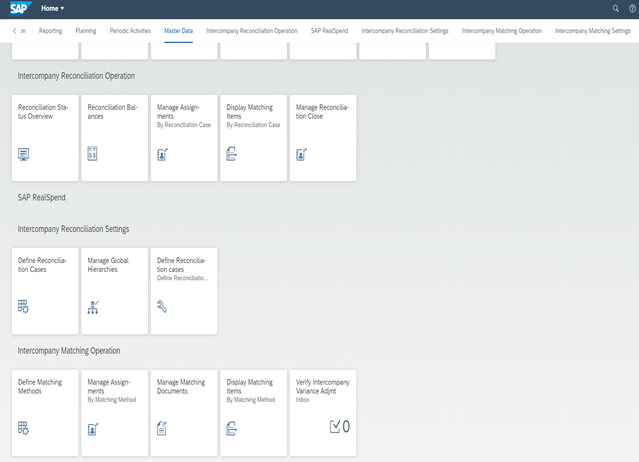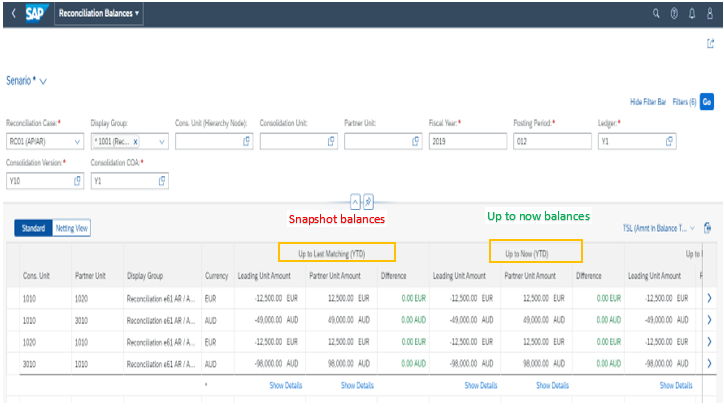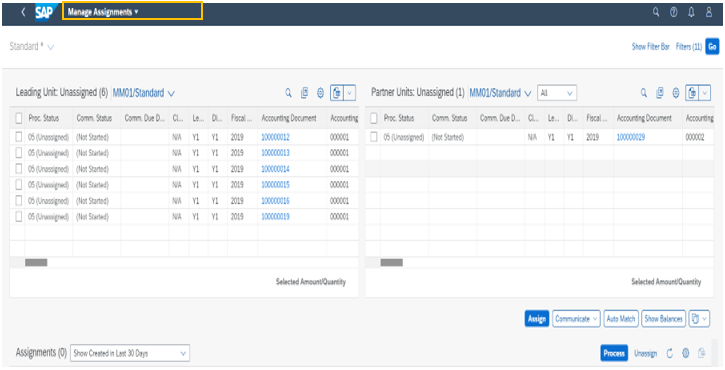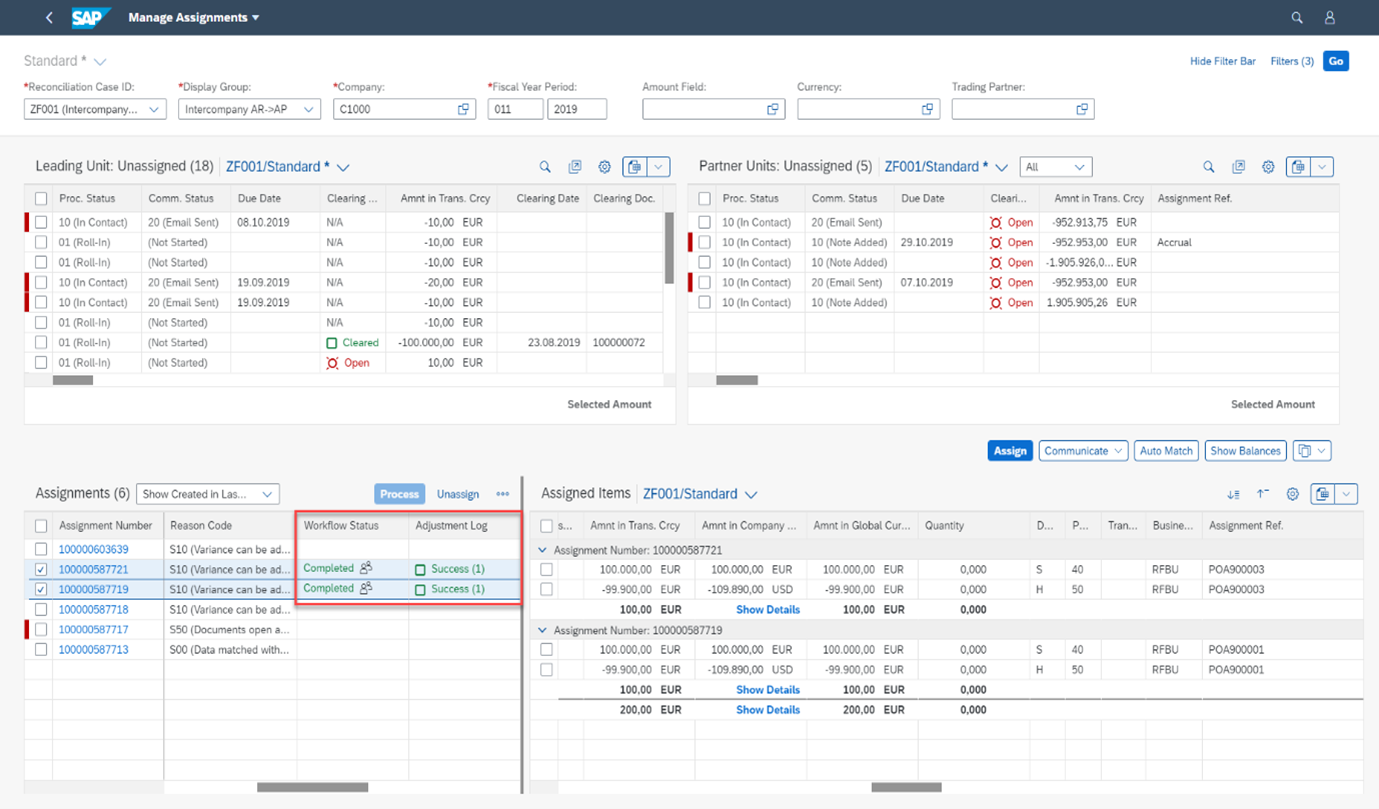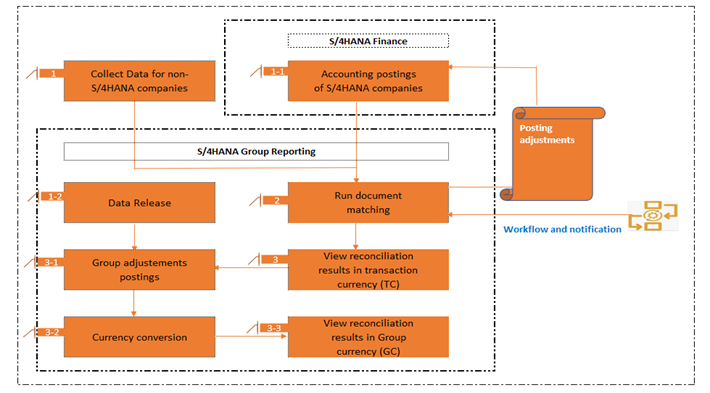What is Intercompany Reconciliation?
Intercompany reconciliation is the process of ensuring that trades between individual subsidiaries within a group net to zero. For example, when one subsidiary acts as seller to another subsidiary, for example a product is sold from subsidiary A to B, the related trade payables and receivables recorded on the balance sheets of these subsidiaries should net to zero when adding them together. If this is not the case, the consolidated financial statements of the group will be over- or understated. Due to this type of trading, we need to reconcile the transactions between these two subsidiaries to ensure the right figures appear on the financial statements of the group.
Introduction of the New Intercompany Matching & Reconciliation (ICMR) in SAP S/4HANA Group Reporting
The new Intercompany matching and reconciliation (ICMR) module, within SAP S/4HANA Group Reporting can enormously accelerate the intercompany reconciliation process between subsidiaries. As an integrated solution, in both the on-premise and cloud versions of S/4HANA Group Reporting, it can match transactions recorded in the general ledger directly without the use of ETL (Extract, Transform, Load) to populate the data for the matching tool. Consequently, it is possible to process and coordinate your financial data in real time.
SAP ICMR comes with a complete redesign of the intercompany process, by defining flexible matching and reconciliation rules, you can achieve a high degree of automation. In addition, its in-app communication and workflow capabilities eliminate the delays that often occur when dealing with discrepancies between subsidiaries, while improving the visibility and transparency of the reconciliation process.
The solution comes with the following key features:
- Flexible matching and reconciliation rule definition
- High visibility on your reconciliation process
- User-friendly Fiori apps to manage your matching assignments on aggregation or line item level.
- In-app communication and workflow
- Possibility to enable automatic discrepancy adjustment.
- Real-time reconciliation
- High performance on matching and reconciliation
- Supports user-defined organizational dimensions for matching and reconciliation.
What we see in the following print screen are tiles of the S/4HANA interface that access the various applications within ICMR. Using these applications, an administrator can setup various features of ICMR as well as an end user who would be able to use other applications to review balances or transactions.
SAP ICMR brings considerable innovations for intercompany reconciliation.
In SAP S/4HANA, the common universal journal form (ACDOCA) was introduced. This not only simplifies the architecture of the application, but it also provides more possibilities. In particular, the most interesting is real-time analysis.
ICMR supports real-time verification of constantly updated data sources. At the same time, it allows to create snapshots, which means that when you want a stable data state, you only need to record a timestamp to create a version of the data set. The main advantage of this continuous data stream is that the accountants involved in the reconciliation process do not need to wait until the period close to re-view and reconcile transactions. This check process can be performed throughout the month, even prior to month-end clos.
The print screen below is the starting point for reviewing these balances. It is the reconciliation status overview application, which provides a single view to evaluate and reconcile data in aggregate form at the company level. From this view, the accountant can drill down from the summary data view to balances at the account level detail and then on to specific transactions that make up a balance.
Once an accountant has drilled down from an entity counterparty relationship, they are taken to the Reconciliation Balances application, which can be seen in the following print screen. At this point, we can see the balances at the account level. The accountant can review amounts in the transaction currency of the entity’s or the group’s presentation currency by selecting the TSL option to the right of the screen.
It is also possible to re-view all balances either as year to date positions, periodically or as last loaded values. These different views provide the accountant with the maximum amount of information to resolve a mis-matched balance.
Finally, the accountant can then drill down to the transaction level from the balance level. At this point, non-assigned transactions can be reviewed and assigned by both parties. Furthermore, document line items belonging to the same business transaction are grouped under the assignment number.
A major advantage of using ICMR is the availability of process states at the transaction level. The transaction matching portion of the application assigns each trade to a specific state. If a transaction reconciles, the trades are assigned a status of matching.
The valuable part is when a trade does not reconcile. If for example, if a trade has matching values but the entity and counterparty have recorded different currencies, ICMR can be setup to detect this difference and can then flag that transaction with a specific status. By assigning different states to transactions, the user is guided to a resolution in the matching process. These different states then guide the accountants involved to take specific actions to resolve a difference.
Furthermore, you can add workflow to the matching process and apply automatic adjustment logic which can be defined to resolve specific differences automatically in a controlled and traceable manner.
Below is the review application for transactions.
The following screen displays a list of pre-build reason codes that could be applied to a specific transaction. By using these reasons, an accountant can see that a traded is either matched not matched due to examples such as open items longer than 30 days, there are goods in transit or another reason.
ICMR Group Financial Close
A Group accountant can use ICMR constantly to match documents between consolidation units, monitor the reconciliation status, and make adjustments from the Group's perspective before the data is ready for consolidation.
The following figure illustrates how ICMR is integrated into the group close process, with step-by-step instructions:
SAP S/4HANA or non-SAP S/4HANA financial data is collected through various methods, such as data release, flexible file import or data import via API
You can perform document matching on the collected data. For identified data differences, adjustment postings can be initiated automatically or through a workflow.
After performing group adjustment postings and currency conversion tasks, you can view the reconciliation results by transaction currency (TC) or group currency (GC).
SAP ICMR benefits compared to SAP ICR
SAP Intercompany Reporting (ICR) was the pre-existing intercompany matching tool in SAP ECC. The previous solution using the SAP Intercompany Reporting (ICR) tool could ensure that different data and documents from the primary and auxiliary accounting were mapped through various processes and transactions. For users, there was not only a significant additional work in reconciling, but it also made the processes much more complex since they are not always traceable or clear.
S/4HANA completely changed everything. The three separate reconciliation processes that had to be set up in the ECC system were combined into one reconciliation process through SAP ICMR, which greatly reduced the reconciliation workload and increased the flexibility of execution.
Processes were improved fundamentally and automated further with S/4HANA.
ICMR has the potential increase the speed and accuracy of the intercompany matching process for a group. The main benefits of ICMR include ability to check and automate reconciliation at the transaction level. This review process can be performed throughout an entire month so that when month end closing process starts most of the matching process has already been completed.
Additional functionality like peer to peer communications and enhanced workflows allow for clearer more streamline approach for communication between subsidiaries.
Consequently, the overall process of intercompany reconciliations is much faster and simplified using ICMR. ICMR not only allows you to further increase the speed of automation of inter-company bookings, but also makes the best use of its potential by integrating it into the new working environment of S/4HANA and Fiori.
More information
Continue reading or contact us to get started:
